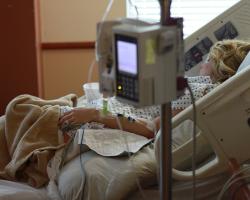A doctor giving anaesthesia may take care of only one patient, and has to be accompanied by a nurse anaesthetist. The patient has to give consent for the anaesthesia, and the confirming document should be attached to the medical history.
The standards in the field of anaesthesiology is defined in the regulation of the Minister of Health on medical standards in the field of anaesthesiology and intensive care for entities performing medical activities.
Under the standards, anaesthesia - general and specific: epidural and spinal - may be performed only by a medical specialist in the field of anaesthesiology and intensive care.
The anaesthesiologist's duties
A doctor specialising in anaesthesiology and intensive care takes over on call resuscitation and decides on stopping it.
During the giving anaesthesia he/she cooperates with the nurse anaesthetist. This also involves anaesthesia given outside the operating theatre.
The doctor has to stand by the patient throughout the whole process of giving anaesthesia and may withdraw only to perform resuscitation on another patient and only in case he/she decides that it will not endanger the life of the patient under anaesthesia; in such a case the patient is accompanied by the nurse anaesthetist.
Before the procedure the anaesthesiologist must get acquainted with the medical records and perform - not later than 24 hours before the planned procedure - a test qualifying the patient for anaesthesia. He/she may also refer the patient for additional tests and consultations.
The patient transported to the operating theatre has to be accompanied by the anaesthesiologist, After the procedure, the patient should be transported to the post-anaesthetic care room.
Anaesthesiologists during the completing of their specialism
A doctor completing his/her specialism may give anaesthesia when supervised by a specialist doctor.
With Head of the Department’s consent, the specialist may at the same time supervise the administering of anaesthesia by not more than three doctors who have not yet completed their specialisms.
The anaesthesiologist supervising doctors who have not completed their specialisms should be in the direct proximity of the patient during the whole period of the anaesthesia.
Within the specialism completion doctors have to undergo at least two-years’ training in the field of anaesthesiology and intensive care and prove they have the necessary knowledge and skills to give anaesthesia.
The anaesthesiology department
The number of beds in the anaesthesiology and intensive-care department should make up at least 2 percent of the total number of beds in the hospital.
In the department, there should be an isolation room with a sluice that facilitates washing hands, changing clothes and storing isolation materials.
Within the surgical suite or its proximity there have to be post-anaesthetic care rooms.
The anaesthesiology department should be run by a specialist in the field of anaesthesiology and intensive care, and the department nurse should have completed the specialism in the field of anaesthesiology and intensive-care nursing.
The department should admit patients who require pain management, invasive diagnostic or therapeutic procedures or proper monitoring or treatment. A team for acute, mainly post-operative, pain management can also be created.









Comments (0)